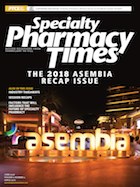Publication
Article
Specialty Pharmacy Times
Value Takes Center Stage at Asembia
Author(s):
As industry leaders converged on the largest annual conference focused on specialty pharmacy, issues surrounding value dominated the conversations at the Asembia Specialty Pharmacy Summit 2018.
As industry leaders converged on the largest annual conference focused on specialty pharmacy, issues surrounding value dominated the conversations at the Asembia Specialty Pharmacy Summit 2018. The annual event took place during what is shaping up to be a transformative time in the health care space.
In a recent speech addressing the high cost of pharmaceuticals in the United States, President Donald Trump called for “tougher negotiation, more competition, and much lower prices at the pharmacy counter.” As noted in a March 2018 editorial in Forbes, the average cost of bringing a new medication to market in the country is approximately $2.4 billion, with the entire process taking around 12 years before gaining FDA approval.
Meanwhile, pharma manufacturers get only about 8 years of patent exclusivity because of FDA regulations inhibiting the process, which leads to new drugs being launched at an astronomical cost to recoup their investment, according to Forbes. But when these drugs are launched overseas, they are frequently priced at a fraction of the cost because these countries may permit copies of the drugs to be sold by other companies. As noted in an article on page 28 discussing ongoing legislative efforts to address drug costs, the president plans to take action to end what he calls “global freeloading, in which drug pricing is reduced in countries other than the United States, where the investment funds originate. As such, fair pricing and defining value in the US drug market has never been more important.
Having a role in these discussions is vital to the specialty drug industry, as specialty spending grew 9.3% last year, while tradi- tional spending dropped 4.0%, according to the IQVIA Institute. However, as noted on page 14 in our recap of the featured Asembia session, more than two-thirds of the growth in specialty spending is the result of usage, not unit cost. The article also addresses some of the challenges that persist in reimporting prescription drugs from other countries.
The Trump administration is also work- ing to remove barriers to generic and biosimilar drug development and market entry to foster competition. Make no mistake, competition will be among the key components of lowering prices. In a session discussing the value of oncology drugs (page 24), panelists cite the hundreds of gene and T-cell therapies currently in the pipeline. According to Bill McGivney, PhD, with treatments that have limited clinical differentiation, the need for financial differentiation will provide the leverage to lower costs.
In the middle of all these discussions is the ongoing movement toward value-based care and the differing definitions of value among the various stakeholders in the specialty space, with specialty pharmacists and manufacturers having a different perception of value. A key takeaway from the session on the value of oncology drugs is that a definition of value from the government is unlikely. Therefore, specialty pharmacists must advocate for a role in how to determine value-based payments.
You can be assured that these discussions will continue to take the spotlight at the upcoming National Association of Specialty Pharmacy 2018 Annual Meeting and Educational Conference, taking place September 24 to 26, 2018, in Washington, DC. Don’t miss out on the chance to make your voice heard by registering at naspmeeting.com/general-information?link=agenda#agenda.
Mike Hennessy, Sr
Chairman & CEO







